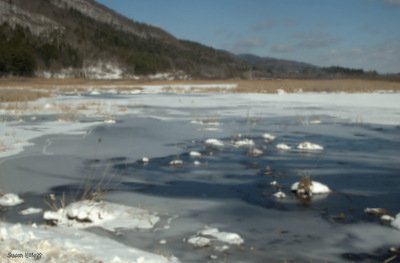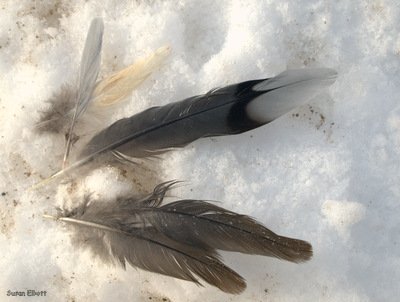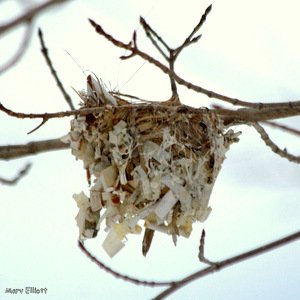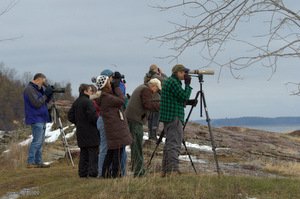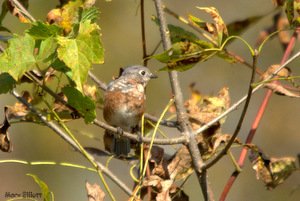In his introduction, Peter Matthiesen asserts that to understand the origin and previous nature of a single living thing (as he attempts with his transcontinental research of the status of 'Grus' - crane species), is one way to grasp the main perspectives of environment and biodiversity. He bears this out in his book, as he not only informs us of worldwide studies of crane populations, breeding sites and migration routes, but also puts such work within the scope of differing cultural environmental attitudes and the consistent flux of biodiversity.
 Sandhill Crane in Brandon, VermontAbout the first quarter of the book is given to Matthiesen's peregrination traversing breeding grounds in the Siberian watershed of the Amur River, on into Mongolia and central Asia, culminating in a large international crane conference. At first, the reader is heartened to discover that there are knowlegeable ornithologists in remote lands dedicated to crane preservation and restoration. Yet their earnest good will and work is still riven by simmering longstanding political animosities: on a multicultural river-based crane survey on the Amur River, the Chinese complain they have not been given their fair share of limited places on an onshore excursion, while Russians grumble that the Chinese are too starchly dressed, with shoes and shirts, for field work.
Sandhill Crane in Brandon, VermontAbout the first quarter of the book is given to Matthiesen's peregrination traversing breeding grounds in the Siberian watershed of the Amur River, on into Mongolia and central Asia, culminating in a large international crane conference. At first, the reader is heartened to discover that there are knowlegeable ornithologists in remote lands dedicated to crane preservation and restoration. Yet their earnest good will and work is still riven by simmering longstanding political animosities: on a multicultural river-based crane survey on the Amur River, the Chinese complain they have not been given their fair share of limited places on an onshore excursion, while Russians grumble that the Chinese are too starchly dressed, with shoes and shirts, for field work.
Likewise, those motivated to advocate development of large crane reserves face the oft unspoken conundrum that the Chinese like the idea of nature as an abstract, witnessed by the prominence of it in their art, but the reality makes them uneasy. In the Cultural Revolution, cranes were decimated as a food source, despite their traditional spiritual embodiment as sentinels of heaven, omens of longevity and good fortune. More recently, in San Jiang, or Three Rivers, which is the heart of the breeding range of the Red-Crowned Crane, the wetlands were drained to create seven hydroelectric dams and the "Great Northern Breadbasket."
Matthiesen's travels in search of cranes take more than a decade, and he presents them in reverse chronological order, beginning with the most recent in Siberia, gradually going back in time through China, Japan, Korea, Southeast Asia, India, Africa, Australia, Europe and North American (South America has no cranes). Specific facts of crane behavior, anatomy, coloration, etc., are introduced along the way. An interesting point noted is that cold climate species lay darker eggs, whereas white eggs will reflect the heat of a warmer climate.
The author describes each species more specifically as he encounters them: there are eleven species of the genus Grus. Oddly it is not until page 147 that he goes into a more comprehensive comparison of each species' color pattern variations, facial features, size, calls, etc., that result in the current genus and species delineation. I would have appreciated a few pages of such a didactic approach at the beginning, to get me grounded. An immense aid in this respect, are several pages of eloquent crane paintings by Robert Bateman, an acclaimed wildlife artist. These are not field book rendtions, but figurative work of cranes in their habitat - preening, calling, wading, and flying. All have a softened tone, in keeping with the legendary sentiment of a mystical bird. There are also four pages of "portraits" which allow closer study of head colors and markings.
This book also is a traveler's essay since Mattiesen is very dependent on local guides, not only for reaching prospective crane sites, but also for shelter, food, and vehicular transport. Thus the reader learns much of the cultural and physical differences of inner and outer Mongolians, the details of ger (yurt) construction, and, in India, the complexities of dodging Hindu and Muslim riots to get to the hinterland.
Overall, I came off impressed by the great fluidity of crane numbers and success, their travels and breeding grounds. After all, in 1979, more than three centuries after it was last reported, the Eurasian Crane returned to England as a breeding species. Yes, the declines and absences are often of human origin, but they may also be due to natural disasters or incremental enviromental changes. Some are still a mystery.
At the end, I believe Peter Matthiesen is still hopeful. He was triumphant, when in attempts to develop a non-migrating crane population in Florida, after 211 trasport egg tries (cranes lay two eggs; since usually only one survives, the second is often taken by scientists for studies and to establish captive flocks), one Whooping Crane was finally hatched, the first born in the U.S. in sixty years.
This book is available at the Rutland Free Library.
Note: Aside from the endanged Whooping Crane, North America has a healthy population of Sandhill Cranes. While usually found well west of Vermont, a pair of Sandhills has successfully bred in the Bristol area for several years. Occasionally in migration Sandhill Cranes may be spotted in Rutland County such as one in Brandon last spring (see photo). Click here for an eBird map of Sandhill Crane sightings in Vermont.
 Chestnut-sided WarblerIf you answered yes to the final question then meet Rutland County Audubon and friends on Sunday, May 26, at the West Rutland Price Chopper parking area at 6:00 am. For those who stay to “the glorious end” some 15 hours later we hope to have tallied over 100 species. If the past is any guide, the number of species tallied over the past five years is 106, 108, 114, 109 and 110!
Chestnut-sided WarblerIf you answered yes to the final question then meet Rutland County Audubon and friends on Sunday, May 26, at the West Rutland Price Chopper parking area at 6:00 am. For those who stay to “the glorious end” some 15 hours later we hope to have tallied over 100 species. If the past is any guide, the number of species tallied over the past five years is 106, 108, 114, 109 and 110!



